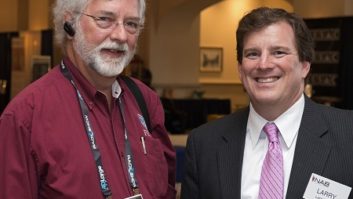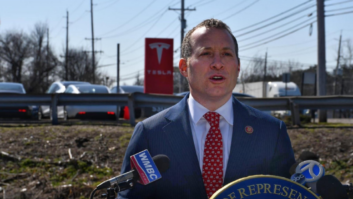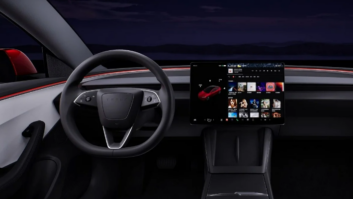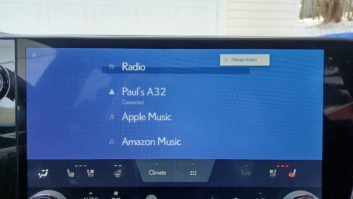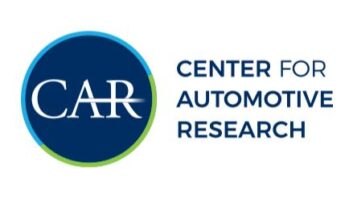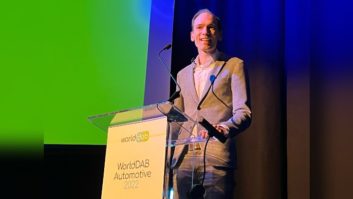
iStockphoto/Daisy-Daisy Fred Jacobs created the classic rock format and is president of Jacobs Media, the largest radio consulting firm in the United States specializing in rock formats. The company is active in the digital space and helps integrate digital, mobile and social strategies with heritage media brands.
In conjunction with the new Radio World eBook “HD Radio in the Connected Car,” Radio World asked Jacobs about connectivity concerns.
RW: You are a programming expert and an app developer; you’ve blogged and produced conferences about connected car issues. What questions should broadcasters be asking about the dashboard?
Jacobs: Because the car is the #1 listening location for radio and the #1 revenue category, the changes in the automotive industry should be on every radio manager’s radar screen. The vast majority of car company executives concur that AM/FM radio is an essential element of the dashboard. And consumers in the market for a new car will tell you that a “regular radio” is of utmost importance in the next vehicle they buy or lease.
But that said, the automakers believe strongly in giving consumers whatever they want in the audio infotainment ecosphere. This means satellite radio, streaming apps, podcasts and whatever else they want. Most automakers will tell you they conduct considerable consumer research — quantitative and even ethnographic — where they’re inquiring about popular audio options and observing drivers in action. The bottom line is that there’s a hole in the fence, allowing new content to be easily accessible in the dash.
The other piece is the invasion of Apple and Google. Their new products — CarPlay and Android Auto, respectively — mimic a consumer’s smartphone on the dash. Radio stations may or may not be represented on these platforms. Given the loyalty that people have to their phones, this is another gnarly issue.
Just this past week we are seeing ads on television for car dealers and the OEMs promoting CarPlay and Android Auto. They believe this will have strong appeal to consumers, so we can expect adoption to be strong because of the allure and penetration of these respected tech brands.
And finally, there’s the dealership training piece. Radio needs to rethink its relationship with local car dealers, meaning they shouldn’t just think of these local businesses as a place to sell spots. Consumers are trained on how to use their sophisticated connected cars often by the salesperson who sold them the car. Making sure that AM/FM radio is a priority for these trainers is another factor that comes into play.
So here are some questions that every broadcaster should be asking:
• Do I have an understanding of the changing connected car landscape and technology? Does my staff?
• Do I have a smart mobile strategy that includes a great mobile app on both the iOS and Android platforms that provides a solid user experience or “UX”?
• How should we redefine our relationships with local car dealers, making sure that we are an effective marketing partner and that our stations are top-of-mind within the dealership and among their sales reps and trainers?
• How should I rethink our station’s programming and brand assets to ensure that when a consumer sits down in their connected car, he/she will find my content, my personalities and my local connection essential to listen to among all those options?

Fred JacobsRW: What does car connectivity mean for broadcasters’ long-term business model?
Jacobs: Broadcasters may find themselves in a position to have to reprove their appeal, both as advertising vehicles and as sources of entertainment and information. OEMs and their dealers are demanding accountability and data, rather than simply making a buy and hoping that car buying prospects here the spots.
Radio remains primarily an analog business, but all of the trends in automotive advertising and in media distribution are rapidly moving toward digital. Clearly, the competition for both advertising dollars and the consumers’ attention and time are amping up — quickly — and broadcasters are going to have to adjust their business model quickly.
RW: How should HD Radio fit in this fast-developing environment?
Jacobs: It’s an interesting dichotomy in that many broadcasters have questioned the efficacy of HD Radio, while many car makers insist that the digital interface is the only one that makes sense. Many on the automotive side will tell you the goal is to have a consistent look, feel and experience (album art, search, etc.) as consumers move from Pandora to Sirius to their favorite FM stations.
iBiquity did good work with the OEMs the past several years, creating direct relationships. I spoke with DTS CEO Jon Kirchner while in Las Vegas. He is all about the importance of automotive. It makes sense to look at them as an important entry point for the industry on which to form — and grow — relationships with the auto industry.

Virtual reality meets the autonomous car at the 2016 CES show.RW: Is there a revenue stream for broadcasters in HD Radio?
Jacobs: As HD Radio penetration improves in new cars that are sold and leased, it feels like that tipping point will be reached. At what point will a majority of broadcasters begin to focus on HD Radio, HD2 and HD3 stations to take advantage of that potential is a good question. That means commitments and goal-setting for HD2 stations — how they’re programmed and sold. But ultimately, if there’s an audience, there’s revenue.
RW: How can the industry grow its digital listenership?
Jacobs: There are two key ways. First, improve the digital experience. Make sure the UX is solid and that streaming, podcasts, mobile apps and other digital assets are competitive with everything else consumers are listening to. Second is to promote these assets — something that broadcasters have been hesitant to do because of fears their audience will leave the AM or FM band to access them on the Web. Radio broadcasters are going to have to truly commit to digital in order to realize its audience and revenue potentials.
RW: How does NextRadio fit into this discussion?
Jacobs: NextRadio has a lot of potential, especially among those who love their smartphones and have favorite radio stations where they live and work. The data issue is an important one to many consumers who will change their media usage behavior when they at or near their data limits. The interactive nature of NextRadio has a younger appeal, and broadcasters could most definitely use injections of both millennials and the “cool factor.”
RW: What did you see at CES that we should know about, regarding HD Radio or connected cars in general?
Jacobs: Apple and Google are now being considered partners rather than predators by many automakers who may have been leery of these tech companies a year or so ago. This is going to turbocharge the proliferation of these platforms in cars, which will accelerate consumer adoption, thus creating a challenge for broadcasters.
Autonomous driving is coming — whether consumers are excited about it or not. What this will mean to radio is still debatable. But many in the automotive community feel that “drivers” of these cars will have their eyes free to be able to do other things in the car — like email, web surfing, videos and other activities. Whereas radio had a virtual monopoly on in-car entertainment, that could very likely change when autonomous hits critical mass.
As we see every year, the level of energy and innovation at CES is beyond description. It’s a vortex of new thinking and creativity. Anyone who thinks that things will settle down any time soon is mistaken.
RW: If a radio manager wants to act now to respond to all these developments, what steps should they take, how should operations change?
Jacobs: I covered a lot of this ground in the opening question.

Read what observers like Sam Matheny of NAB, Erica Farber of RAB, Scott Burnell of Ford, Mark Ramsey of Mark Ramsey Media, Roger Lanctot of Strategy Analytics and Geoff Snyder of Pandora have to say about HD Radio and the greater world of the connected car. Access the free eBook “HD Radio in the Connected Car” at radioworld.com/ebooks.
I’d be asking my corporate chieftains about global plans to address the mobile and automotive spaces, as well as for research dollars to better understand how the space is changing.
I would go to a conference like CES or a connected car-specific event in order to better understand the automotive mindset.
I would totally examine (or re-examine) my station’s mobile strategy. Just having an app is table stakes. How can consumers use it, where can they use it, is it accessible on the Apple and Android platforms?
I would rethink the station’s car dealership relationship. Take the time to listen to local car dealers to understand their changing needs regarding accountability, ROI and media spend?
I would aggressively put together advertising packages that combine traditional messaging with digital assets to provide true integrated campaigns. I would work with the station’s production team to brainstorm more effective, results-oriented concepts.
A key is to stop thinking about Nielsen ratings as the only metric that matters. We are moving into a digital world, and commerce will be based on new metrics surrounding digital. Incentives, bonuses, and goals will need to be reconfigured in order to create a culture based on the future and more in alignment with where revenue and audience attention is
heading.
I would design dealership visibility campaigns to ensure that when a consumer buys/leases a new car, the dealer trainers/sales reps are thinking about broadcast radio. Setting those pre-sets has never been more important.
Jacobs Media also co-produces the DASH conference; sibling company jacAPPS designs mobile apps. For information visit www.jacobsmedia.com.






